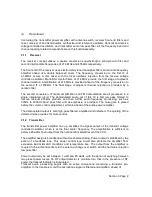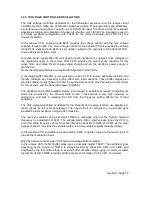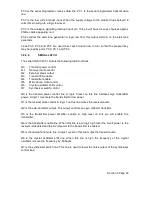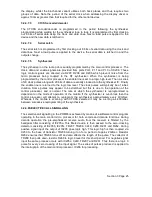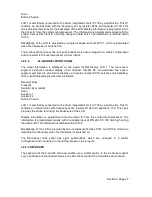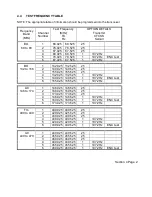
The loop filter OP AMP do supply is produced by a voltage tripler circuit on the control board.
This 23 volt supply enables the loop filter output to control the varicap diodes of the VCO and
receiver front end over a wide capacitance range. Using the higher control voltage on the
varicaps is preferred to using tighter varicap coupling, which would result in noise degradation.
To improve the signal-to-noise ratio of the OP AMP output control voltage, it is necessary to
maintain the voltage above 7 volts. This is achieved by a switched voltage divider using R532
and R533. For channel frequencies in the lower 1/3 of the operating frequency band, transistor
TR414 is activated by the microprocessor to switch in the voltage divider. This causes the loop
to increase the OP AMP output voltage so as to maintain the correct control voltage on the
VCO. The divider circuit is switched out for channel frequencies above the 1/3 of band point.
Resistors R532 and R533 are metal film to minimize control voltage noise.
The second half of the dual OP AMP IC404 is used to provide a tracking voltage for control of
the receiver front end. The tracking voltage range is adjusted by the tracking gain
potentiometer, R557, and the offset is adjusted by the tracking offset potentiometer R554.
These adjustments are set to ensure that the centre frequency of the receiver front end tracks
the tuning of the local oscillator VCO.
3.2.3.6
REFERENCE OSCILLATOR
Transistor TR413 is configured in a modified Pierce oscillator circuit using a quartz crystal
XL401 in the feedback path. Feedback occurs between the base and collector of TR413 which
provides 180 degree phase shift. The crystal operates in a parallel resonance mode to provide
a further 180 degree phase shift. The oscillator is tuned to the correct frequency of 10MHz by
a tunable coil, L411, placed in series with the crystal. Varicap diode D435 which is also in
series with the crystal is reverse biassed to approximately 4.5 volts. The transmit audio is ac-
coupled to this diode by C542, as part of the two-point modulation technique.
The oscillator output of approximately 1.5 volt peak-to-peak is connected to the programmable
reference divider at PIN 9 of IC403. The reference oscillator signal also appears at PIN 10 of
IC403 at a level of 5 volt peak-to-peak.
For extended temperature operation down to -30 Deg C, a crystal heater is employed.
Transistor TR425 is activated when the transceiver is switched on and passes current through
the positive temperature coefficient resistor R620.
The PTC has intimate thermal contact with XL401. For temperatures below approximately 0
Deg C the resistance reduces and more current is drawn. This results in self heating of the
PTC. The effect is to maintain a crystal temperature of not less than -10 Deg C for ambient
temperatures below 0 Deg C.
For higher temperature stability than is achieved with a standard crystal, a temperature
compensated crystal oscillator (TXCO) option may be fitted. When XL402 is fitted the discrete
reference oscillator, using TR413 and XL401, is not used. Adjustment of the frequency of the
TCXO is provided on the module.
Section 3 Page 15


